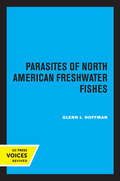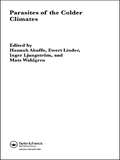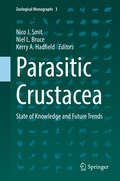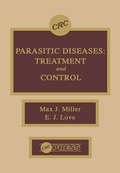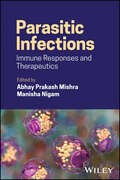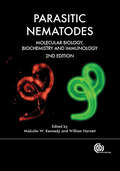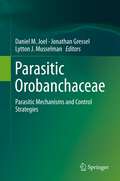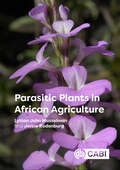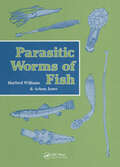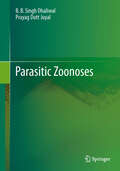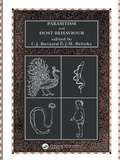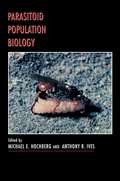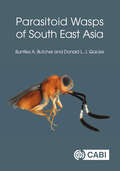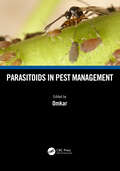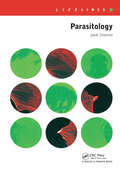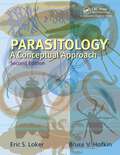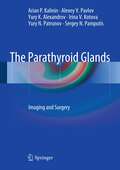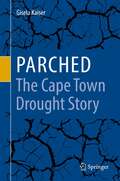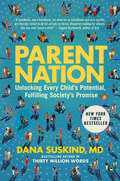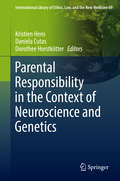- Table View
- List View
Parasites of North American Freshwater Fishes
by Glenn L. HoffmanThis title is part of UC Press's Voices Revived program, which commemorates University of California Press’s mission to seek out and cultivate the brightest minds and give them voice, reach, and impact. Drawing on a backlist dating to 1893, Voices Revived makes high-quality, peer-reviewed scholarship accessible once again using print-on-demand technology. This title was originally published in 1967.
Parasites of the Colder Climates
by Hannah Akuffo Ewert Linder Inger Ljungström Mats WahlgrenThe parasitic load in cold northern climates is widely under-appreciated. Many texts on parasitology concentrate on tropical parasitic infections, so the reader can be forgiven for thinking that parasites are not a problem in the northern part of the world. Parasites of the Colder Climates redresses the balance by focusing on parasites indigenous t
Parasitic Crustacea: State of Knowledge and Future Trends (Zoological Monographs #3)
by Nico J. Smit Niel L. Bruce Kerry A. HadfieldThis book offers the first comprehensive review of parasitic Crustacea, which are among the most successful and diverse parasites. Starting with an introductory chapter, followed by an historic overview and topic-specific chapters, each presenting a different aspect of parasitic crustacean biology, it enables readers to gain a better understanding of how these parasites function and allows direct comparisons between the different parasitic crustacean groups. The authors also discuss, in depth, the adaptations and interactions that have made parasitic Crustacea as successful as they are today, covering topics ranging from the history of their discovery, their biodiversity, phylogeny, evolution and life strategies to their role as vectors, or hosts of other organisms, and their significance in ecological processes. Consisting of ten chapters from leading international experts in the field, this volume offers a one-stop resource for all researchers, lecturers, students and practitioners.
Parasitic Diseases: Treatment & Control
by Max J. Miller Edgar LoveBased on papers presented at the XI International Congress for Tropical Medicine and Malaria, this publication provides an authoritative evaluation of treatment and control of helminth parasite infections. A section on leprosy and a brief review of malaria vaccination are included. A comprehensive review of the history of schistosomiasis control programs presents information unavailable elsewhere. This book is of special interest to professionals concerned with health problems of less developed countries and in particular to public health officials, epidemiologists and clinicians dealing with patients in or returning from the tropics.
Parasitic Flatworms: Molecular Biology, Biochemistry, Immunology and Physiology
by Nikki J. Marks Aaron G. MauleParasitic flatworms include Cestodes (tapeworms) and trematodes (flukes, schistosomes, etc) and are the cause of a number of major diseases of medical and veterinary significance. Much recent research has focused on molecular biology and genomics. this book aims to review advances in our understanding of these and related topics such as flatworm biochemistry, immunology and physiology. Where appropriate, comparisons are made between different parasitic flatworms and between parasitic and free-living species. Contributors to the book include leading authorities from Europe, North and South America, and Australia.
Parasitic Infections: Immune Responses and Therapeutics
by Abhay Prakash Mishra Manisha NigamParasitic Infections Understand and defeat a scourge of public health with this cutting-edge guide Parasitic diseases are considered as an important public health problem due to the high morbidity and mortality rates, particularly in countries where climate and level of economic development create serious challenges to the creation of public health infrastructure, thus can make parasitic infections both graver and more difficult to contain. As we come to understand the global ramifications of public health, there has never been a more crucial time to understand these infections and the processes by which they can be managed and defeated. Parasitic Infections is a comprehensive overview of parasitic immunopathology, including the fundamentals of parasite biology, mechanisms and processes of infection, and the key steps of drug discovery and treatment. In addition to detailed coverage of the most commonly encountered infectious parasites, analysis of the immune system provides material pertinent to any possible parasitic infection. The result is an essential contribution to public health research. Parasitic Infections readers will also find: A careful balance of parasite immunopathology and pharmaceutical analysis Detailed discussion of parasites such as protozoans, helminths, and ectoparasites Case studies and in-depth analyses written by authors around the world on the basis of first hand investigation Parasitic Infections is a must-read for researchers or professionals in immunology, biology, medicinal chemistry, drug development or pharmaceutical research, and all related fields.
Parasitic Nematodes: Molecular Biology, Biochemistry and Immunology
by Judith Allen David Artis David Bird Susanne Hartmann Collette Britton Jonathan Ewbank John Gilleard Bernadette Connolly Richard Grencis Julian Hopkin Peter Hotez David Knox Sara Lustigman Rick Maizels Aaron Maule Thomas Nutman Tony Page Marie-Noëlle Rosso Roger Prichard Rupert Quinnell Ralf Sommer Mark Taylor Mark Viney Joel Weinstock Sarah Williams-BlangeroParasitic Nematodes are amongst the most successful parasites on Earth. This fully-updated second edition constitutes a comprehensive volume that continues to discuss the molecular biology, biochemistry and immunology of nematode parasites of humans, domestic animals and plants. There is a strong focus on new advances including chapters on horizontal gene transfer, genetics of susceptibility in humans, nematode protein structures, role of bacterial symbionts, host immune system modulation, modulation of allergic and autoimmune diseases by parasitic nematodes and the use of these organisms or their products as therapeutics. This book will be of significant importance to advanced students and researchers in human and veterinary parasitology, plant nematology and pathogen immunology in general.
Parasitic Nematodes
by Sara Lustigman Jonathan Ewbank Bernadette Connolly Susanne Hartmann Marie-Noëlle Rosso Joel Weinstock Aaron Maule Judith Allen Tony Page David Artis Rupert Quinnell Richard Grencis Malcolm Kennedy Rick Maizels Peter Hotez Roger Prichard David Knox Collette Britton Sarah Williams-Blangero Ralf Sommer John Gilleard Thomas Nutman Mark Taylor David Bird Julian Hopkin William Harnett Mark VineyCovering a wide range of rapidly-developing fields of research into parasitic nematodes, this comprehensive volume discusses the genetics, biochemistry and immunology of nematode parasites of humans as well as domestic animals and plants. This fully-updated edition also covers new advances including horizontal gene transfer, immune expulsion mechanisms, genetics of susceptibility in humans, nematode protein structures, role of bacterial symbionts, intrinsic immune response, host immune system modulation, modulation of allergic and autoimmune diseases and the use of parasitic nematodes or their products as therapeutics.
Parasitic Orobanchaceae: Parasitic Mechanisms and Control Strategies
by Daniel M. Joel Jonathan Gressel Lytton J. MusselmanThis book was written in response to significant recent advances in understanding the mechanisms of parasitism in the Orobanchaceae, and breakthroughs in the control of the parasitic weeds Striga and Orobanche. It consists of 26 contributions by internationally recognized leading scientists. The main book chapters are grouped into two parts: · Part I - The Orobanchaceae and Their Parasitic Mechanisms · Part II - The Weedy Orobanchaceae and Their Control The first part provides cutting-edge information on all key aspects of plant parasitism, such as the structure, development and function of the haustorium; nutrient transfer and the physiology of the parasite-host association; host reaction to parasitic plants; seed production and germination; the strigolactones and host-parasite signaling mechanisms; the parasite genome, phylogenetics, evolution and epigenetics; and ecology. Topics of the second part include: the problem posed by the weedy parasites; population diversity and dynamics; molecular diagnosis of seed banks; and detailed discussion of the various management strategies, including agronomic, chemical and biotechnological approaches, as well as host breeding for resistance, allelopathy and biological control. This book is intended for plant scientists, university lecturers and students, agronomists and weed specialists, breeders and farmers, extension personnel and experts in tropical and subtropical agriculture.
Parasitic Plants in African Agriculture
by Professor Lytton John Musselman Dr Jonne RodenburgParasitic Plants in African Agriculture brings together for the first time in a single volume, the ecology, biology, damage, and control of all groups of African parasitic plants including both the relatively few parasites introduced to the continent as well as those native parasites that have spread from within Africa. The book covers the well-known witchweeds and broomrapes but also groups and species that have received less attention including mistletoes, dodders, rice vampire weed, and other species posing threats. The book distinguishes between stem and root parasitic weeds and between holoparasites and (facultative or obligate) hemiparasites. Based on their research and experience collectively spanning six decades, the authors provide an authoritative and state-of-the-art overview of the distribution, biology and impact of these highly specialized weeds and include recommendations for their management. Since parasitic plants in African agriculture primarily affect smallholder farmers, these weeds are explicitly discussed within a context of resource limitations and global changes. Readers are informed on all parasitic plant species relevant to African agriculture and the impact these plants have on crop production and livelihoods of smallholders in a changing world. Current and future management strategies are outlined in terms of their principles and effectiveness as well as their feasibility and affordability for farmers, all of which determine farmer adoption. The final chapter synthesises some of the relevant findings and statistics regarding parasitic weed distribution and their host crops and discusses implications in terms of future crop protection concerns in African agricultural systems. Key features: · Authoritative text based on extensive field and laboratory work. · First comprehensive state-of-the-art overview of parasitic plants and their management in Africa. · Highly illustrated with photos, graphs and species distribution maps. · Reviews previous basic and applied work, with relevance to smallholder farming systems. This book will be a valuable reference for students, researchers, extension workers, development officers, national agriculture researchers, plant pathologists, food security specialists, weed scientists, agronomists and botanists.
Parasitic Worms Of Fish
by Hartford WilliamsFish are a unique group which harbour some 30,000 species of helminths that do not occur in other vertebrates. This book deals specifically with parasitic worms of fish. It covers every aspect of their biology including identification, life-cycles, hostparasite relationships and ecology. It discusses approaches to studying parasitic worm infections, preference of species for particular host species, preference for dwelling in certain organs and tissues, biogeography, seasonality of infections and how parasites have evolved in parallel with their hosts. The book concludes with discussions of fish worms causing diseases in nature and in fish-farms.
Parasitic Zoonoses
by Prayag Dutt Juyal B.B.Singh DhaliwalThe book "Parasitic Zoonoses" emphasizes a veterinary and public health perspective of zoonotic parasites. This book is suitable for higher undergraduate and graduate students of zoonoses and public health, veterinary parasitology, parasite epidemiology; public health workers; public health veterinarians; field veterinarians, medical professionals and all others interested in the subject. More than 15 protozoa and 50 other parasitic diseases are zoonotic in nature and all these diseases have been discussed in detail. The first chapter is concerned with classification of zoonotic parasites, food borne, vector borne and occupation related zoonotic parasites. The remaining chapters cover etiology, epidemiology, life cycle, transmission, clinical signs, diagnosis, prevention and control of zoonotic parasites. The text is illustrated with a large number of coloured figures. An alphabetical bibliography for every disease has also been included so that readers have access to further information.
Parasitism
by Timothy M. Goater Cameron P. Goater Gerald W. Esch Timothy M. Goater Cameron P. GoaterAlmost all living organisms are exploited by parasites of one type or another. But what are parasites? How many different types are there? And what exactly is parasitism? In this undergraduate textbook parasitism is described as an ecological relationship. Ecology implies the study of the interaction between organisms and their environments and the fact that parasites' hosts are alive makes this concept even more exciting, combining traditionally disparate disciplines such as immunology and physiology with ecology and epidemiology! All the major groups of animal parasites are described, who they are and how they live. Also examined are their biogeography, evolution, and the way they influence the populations of their hosts and the immunological, pathological and biochemical implications of parasites. Written in an accessible style, the subject matter is brought to life with numerous illustrations and textboxes containing anecdotal, interesting and supplementary material. Essential for all undergraduate students studying parasitology, Parasitism: The Ecology and Diversity of Animal Parasites will also be useful reading for graduates and researchers in zoology and ecology.
Parasitism and Host Behaviour
by C. J. Barnard J. M. BehnkeRecent ideas and experimental studies suggest that the relationship between parasitism and host behaviour has been a powerful shaping force in the evolution not only of behaviour patterns themselves but, through them, of morphology and population and community dynamics. This book brings together recent work across the disciplines of parasitology an
Parasitoid Population Biology
by Michael E. Hochberg and Anthony R. IvesExtraordinary in the diversity of their lifestyles, insect parasitoids have become extremely important study organisms in the field of population biology, and they are the most frequently used agents in the biological control of insect pests. This book presents the ideas of seventeen international specialists, providing the reader not only with an overview but also with lively discussions of the most salient questions pertaining to the field today and prescriptions for avenues of future research. After a general introduction, the book divides into three main sections: population dynamics, population diversity, and population applications. The first section covers gaps in our knowledge in parasitoid behavior, parasitoid persistence, and how space and landscape affect dynamics. The contributions on population diversity consider how evolution has molded parasitoid populations and communities. The final section calls for novel approaches toward resolving the enigma of success in biological control and questions why parasitoids have been largely neglected in conservation biology. Parasitoid Population Biology will likely be an important influence on research well into the twenty-first century and will provoke discussion amongst parasitoid biologists and population biologists. In addition to the editors, the contributors are Carlos Bernstein, Jacques Brodeur, Jerome Casas, H.C.J. Godfray, Susan Harrison, Alan Hastings, Bradford A. Hawkins, George E. Heimpel, Marcel Holyoak, Nick Mills, Bernard D. Roitberg, Jens Roland, Michael R. Strand, Teja Tscharntke, and Minus van Baalen.
Parasitoid Wasps of South East Asia
by Dr Buntika A Butcher Dr Donald QuickeParasitoid wasps are cosmopolitan, numerous and enormously diverse with probably one million or more species worldwide, most of which occur in the moist tropics. Their ecological importance is enormous although perhaps most evident in their major roles in the control of insect pest populations. In natural ecosystems they are integral in regulating populations of a vast number of insects, and therefore are key players in terrestrial food webs. Knowledge of their biology is still very poor because the current state of taxonomy is still in its infancy in most parts of the world. In this book, we provide an overview of the more than 30 families of parasitoid wasps that occur in the 11 countries in South East Asia. Particular emphasis is given to those most commonly encountered and reared, as well as to those used in biological control programmes. Outlines of the morphology, biology, ecology and behaviour of each family, as well as of various important subfamilies are presented. The current state of taxonomy in the region is summarised. Other chapters cover basic biology, behaviour, morphological terminology, phylogeny and methods of specimen collecting, preparation and rearing with particular relevance to the tropics. Modern molecular approaches to speeding taxonomic description of hyperdiverse taxa are considered in depth. All groups are illustrated with colour photographs. This book will be of value to professional entomologists, academics, entomology students and the growing body of amateur entomologists and insect photographers.
Parasitoids in Pest Management
by OmkarPests cause economic damage to crops and stored products, while vectors are responsible for the transmission of disease-causing agents in human beings and livestock. Although the application of synthetic pesticides in agriculture has given immediate relief, it has also caused well-known side effects, leading to a general consensus among entomologists and agriculturists to shift towards other ecofriendly pest management. Insect natural enemies consisting of predators, parasitoids, and pathogens have attracted the attention of scientists across the globe. These natural enemies exist in agroecosystems and suppress the populations of pests. Parasitoids are farmers’ friends and the most successful group of natural enemies. Highly specialised in their host choice, the female parasitoid searches for a suitable host to lay eggs and larvae in, on or near the hosts. Exploiting this potency of parasitoids may yield successful results in controlling notorious pests in an ecofriendly way.This book covers information on the important biocontrol agents effective in pest suppression. It starts with insect parasitic groups followed by specific groups of parasitoids. It is hoped that the book presents a comprehensive account of beneficial parasitoirds, and will be useful to undergraduate and postgraduate students of Entomology, Biological Control, Plant Protection, Agricultural Zoology, and Zoology, besides those involved in competitive examinations and policy planning. Features: • Each chapter has been written by very experienced specialists.• Every chapter includes Learning Objectives and Points to Remember.• This book offers comprehensive knowledge of parasitoids and their application in pestmanagement in a rational way.
Parasitology
by Jack CherninParasitology provides all the basic principles of this increasingly studied subject, emphasised by specific, but important examples rather than covering organisms of just one particular group. It is ideally suited to the new modular/semester system now used by most universities and is laid out in the form of `notes' (rather than detailed descriptio
Parasitology: An Integrated Approach (New York Academy of Sciences)
by Alan Gunn Sarah J. PittParasitology Highly detailed textbook on parasites and parasite relationships The fully revised edition of Parasitology: An Integrated Approach holds true to its engaging and easy-to-read approach. It comprehensively covers the complex and dynamic interaction between the parasite and its host ranging from invertebrates to vertebrates. Following an integrated approach, the authors explain how the study of parasites requires an understanding of biological concepts such as growth and reproduction, molecular biology, biochemistry, immunology, and pathology. In this second edition, they further address parasites and parasite relationships in the grand scheme of global changes and their impact. This textbook also reviews the often-neglected positive aspects of parasite infections and how humans have used parasites for their own advantage. Parasitology: An Integrated Approach, 2nd edition includes supplementary learning resources such as self-assessment quizzes, practical exercises, and an extensive collection of photographs. Now includes parasite life cycles in colour Strong focus on parasite interactions with other pathogens such as bacteria and viruses Discusses major advancements in the field of parasite diagnostics Additional image material and learning resources (quizzes, practical exercises) provided online A valuable and comprehensive learning resource for undergraduate students in the biological, biomedical and veterinary sciences and in medicine. It is also of interest to postgraduates and professionals with an interest including but not limited to parasitology, animal welfare, ecology, and medical microbiology.
Parasitology: A Conceptual Approach
by Eric S. Loker Bruce V. HofkinProduced amidst the still rippling effects of a pandemic and as the world experiences the increasing burden of global warming and a rapidly changing biosphere, the second edition of Parasitology: A Conceptual Approach offers a timely overview of the eukaryotic parasites affecting human health and the health of domestic and wild animals and plants. The book offers a broadly encompassing, integrative view of the phenomenon of parasitism and of the remarkable diversity of the world’s parasites. This second edition has been thoroughly updated on all aspects of parasitism, including expanded sections on parasite biodiversity, parasite genomes, the interface between parasitology and disease ecology, and applications of new techniques like CRISPR and gene drives for parasite control. Key selling features: Emphasis on a distinctive integrative and conceptual approach rather than the taxon-by-taxon approach used in most parasitology books A concise, handy Rogues Gallery section that summarizes the basic biology for the most important eukaryotic parasites of humans and domestic animals, one a reader is repeatedly directed to throughout the chapters Outstanding full-color illustrations and photographs to reinforce key points The use of text boxes to set apart important topics or ideas that deserve special emphasis Provision of end-of-chapter summaries, questions to test understanding and key references for those wishing to seek further information Reference to particular URLs to highlight recent developments that often pose new and distinctive problems awaiting solution Parasitology: A Conceptual Approach is designed for an upper-level undergraduate audience, but its readability and careful explanation of underlying scientific concepts and terminology makes it appropriate for anyone seeking a broader understanding of the impact of infectious organisms on our well-being and the changes underway in the modern world.
Paratexts: Thresholds of Interpretation
by Gérard GenetteParatexts are those liminal devices and conventions, both within and outside the book, that mediate between book, author and reader: titles, forewords and publishers' jacket copy form part of a book's private and public history. In this first English translation of Paratexts, Gérard Genette offers a global view of these liminal mediations and their relation to the reading public. With precision, clarity and through wide reference, he shows how paratexts interact with general questions of literature as a cultural institution. Richard Macksey's foreword situates Genette in contemporary literary theory.
The Parathyroid Glands
by Alexey V. Pavlov Arian P. Kalinin Irina V. Kotova Sergey N. Pamputis Yury K. Alexandrov Yury N. PatrunovThis book is based on the authors' extensive practical experience in the use of modern radiological methods to diagnose parathyroid diseases and the application of advanced surgical techniques. Detailed attention is devoted to the embryological background to emphasize the significance of diagnostic and surgical peculiarities. Pre- and intraoperative imaging is discussed in depth, with a special focus on localizing techniques. Ultrasound-guided minimally invasive techniques, including percutaneous laser ablation, are fully considered. This up-to-date and richly illustrated book will interest and assist specialists in ultrasound diagnostics, radiologists, endocrinologists, and surgeons.
Parched - The Cape Town Drought Story
by Gisela KaiserThe book presents the history of water supply to Cape Town, leading up to the worst ever drought recorded, through political turmoil impacting on drought interventions and resulting in the adoption of an integrated water strategy.Regions reliant on water supply from rainfed dams have always been vulnerable to the impact of drought. This is exacerbated by the uncertainty of future rainfall, which is never guaranteed, and reliance is placed on modelling using historic data. While weather has always been variable, climate has been generally reliable. With anthropogenic activity causing changes in climate, the validity of modelling based on history is currently not fully trusted. Unless the storage capacity is sufficient to carry through numerous seasons of poor rainfall, even with water restrictions to match demand and supply in times of depleted rainfall, the risk of reservoirs running dry remains a threat.
Parent Nation: Unlocking Every Child's Potential, Fulfilling Society's Promise
by Dana SuskindWorld-class pediatric surgeon, social scientist, and best-selling author of Thirty Million Words Dr. Dana Suskind returns with a revelatory new look at the neuroscience of early childhood development—and how it can guide us toward a future in which every child has the opportunity to fulfill their potential.Her prescription for this more prosperous and equitable future, as clear as it is powerful, is more robust support for parents during the most critical years of their children&’s development. In her poignant new book, Parent Nation, written with award-winning science writer Lydia Denworth, Dr. Suskind helps parents recognize both their collective identity and their formidable power as custodians of our next generation. Weaving together the latest science on the developing brain with heart-breaking and relatable stories of families from all walks of life, Dr. Suskind shows that the status quo—scores of parents convinced they should be able to shoulder the enormous responsibility of early childhood care and education on their own—is not only unsustainable, but deeply detrimental to the wellbeing of children, families, and society. Anyone looking for a blueprint for how to build a brighter future for our children will find one in Parent Nation. Informed by the science of foundational brain development as well as history, political science, and the lived experiences of families around the country, this book clearly outlines how society can and should help families meet the developmental needs of their children. Only then can we ensure that all children are able to enjoy the promise of their potential.
Parental Responsibility in the Context of Neuroscience and Genetics
by Kristien Hens Daniela Cutas Dorothee HorstkötterShould parents aim to make their children as normal as possible to increase their chances to "fit in"? Are neurological and mental health conditions a part of children's identity and if so, should parents aim to remove or treat these? Should they aim to instill self-control in their children? Should prospective parents take steps to insure that, of all the children they could have, they choose the ones with the best likely start in life? This volume explores all of these questions and more. Against the background of recent findings and expected advances in neuroscience and genetics, the extent and limits of parental responsibility are increasingly unclear. Awareness of the effects of parental choices on children's wellbeing, as well as evolving norms about the moral status of children, have further increased expectations from (prospective) parents to take up and act on their changing responsibilities. The contributors discuss conceptual issues such as the meaning and sources of moral responsibility, normality, treatment, and identity. They also explore more practical issues such as how responsibility for children is practiced in Yoruba culture in Nigeria or how parents and health professionals in Belgium perceive the dilemmas generated by prenatal diagnosis.
